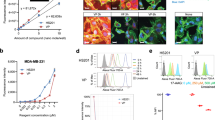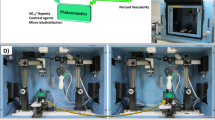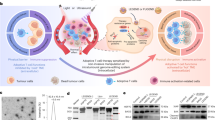Abstract
The ability to achieve tumor selective expression of therapeutic genes is an area that needs improvement for cancer gene therapy to be successful. One approach to address this is through the use of promoters that can be controlled by external means, such as hyperthermia. In this regard, we constructed a replication-deficient adenovirus that consists of a mutated herpes simplex virus 1 thymidine kinase (mTK) fused to enhanced green fluorescent protein (EGFP) under the control of the full-length human heat shock (HS) 70b promoter. The virus (AdHSmTK-EGFP) was evaluated both in vitro and in vivo in oral squamous cell carcinoma SCC-9 cells for expression of both mTK and EGFP. The in vitro expression of mTK-EGFP was validated using both 3H-penciclovir and fluorescence-activated cell sorting assays. These studies show that specific expression could be achieved by heating the cells at 41 °C for 1 h, whereas little expression was observed using high doses of virus without hyperthermia. The vector was also evaluated in vivo by direct intratumoral injection into mice bearing SCC-9 xenografts. These studies demonstrated tumor expression of mTK-EGFP after ultrasound heating of the tumors by radioactive biodistribution assays, histology and microPET imaging. These in vivo results, which demonstrate HS-inducible transgene expression using PET imaging, provide a means for noninvasive monitoring of heat-induced gene therapy in local tumors, such as oral squamous cell carcinomas.
This is a preview of subscription content, access via your institution
Access options
Subscribe to this journal
Receive 12 print issues and online access
$259.00 per year
only $21.58 per issue
Buy this article
- Purchase on Springer Link
- Instant access to full article PDF
Prices may be subject to local taxes which are calculated during checkout





Similar content being viewed by others
References
McCormick F . Cancer gene therapy: fringe of cutting edge? Nat Rev Cancer 2001; 1: 130–141.
Yamamoto M, Curiel DT . Cancer gene therapy. Technol Cancer Res Treat 2005; 4: 315–330.
Rein DT, Breidenbach M, Curiel DT . Current developments in adenovirus-based cancer gene therapy. Future Oncol 2006; 2: 137–143.
Siders WM, Halloran PJ, Fenton RG . Melanoma-specific cytotoxicity induced by a tyrosinase promoter-enhancer/herpes simplex virus thymidine kinase adenovirus. Cancer Gene Ther 1998; 5: 281–291.
Yamamoto M, Alemany R, Adachi Y, Grizzle WE, Curiel DT . Characterization of the cyclooxyygenase-2 promoter in an adenoviral vector and its application for the mitigation of toxicity in suicide gene therapy of gastrointestinal cancers. Mol Ther 2001; 3: 385–394.
Uchino J, Takayama K, Harada A, Kawakami Y, Inoue H, Curiel DT et al. Infectivity enhanced, hTERT promoter-based conditionally replicative adenoviruses are useful for SCLC treatment. Cancer Gene Ther 2005; 12: 737–748.
Scholz IV, Cengic N, Baker CH, Harrington KJ, Maletz K, Bergert ER et al. Radioiodine therapy of colon cancer following tissue-specific sodium iodide symporter gene transfer. Gene Therapy 2005; 12: 272–280.
Greco O, Powell TM, Marples B, Joiner MC, Scott SD . Gene therapy vectors containing CArG elements from the Egr1 gene are activated by neutron irradiation, cisplatin and doxorubicin. Cancer Gene Ther 2005; 12: 655–662.
Yamini B, Yu X, Gillespie GY, Kufe DW, Weichselbaum RR . Transcriptional targeting of adenovirally delivered tumor necrosis factor alpha by temozolomide in experimental glioblastoma. Cancer Res 2004; 64: 6381–6384.
Li CY, Dewhirst MW . Hyperthermia-regulated immunogene therapy. Int J Hyperthermia 2002; 18: 586–596.
Borrelli MJ, Schoenherr DM, Wong A, Bernock LJ, Corry PM . Heat-activated transgene expression from adenovirus vectors infected into human prostate cancer cells. Cancer Res 2001; 61: 1113–1121.
Brade AM, Ngo D, Szmitko P, Li PX, Liu FF, Klamut HJ . Heat-directed gene targeting of adenoviral vectors to tumor cells. Cancer Gene Ther 2000; 7: 1566–1574.
Huang Q, Hu JK, Lohr F, Zhang L, Braun R, Lanzen J et al. Heat-induced gene expression as a novel targeted cancer gene therapy strategy. Cancer Res 2000; 60: 3435–3439.
Li GC, He F, Shao X, Urano M, Shen L, Kim D et al. Adenovirus-mediated heat-activated antisense Ku70 expression radiosensitizes tumor cells in vitro and in vivo. Cancer Res 2003; 63: 3268–3274.
Luker GD, Sharma V, Pica CM, Dahlheimer JL, Li W, Ochesky J et al. Noninvasive imaging of protein-protein interactions in living animals. Proc Natl Acad Sci USA 2002; 99: 6961–6966.
Black ME, Newcomb TG, Wilson HM, Loeb LA . Creation of drug-specific herpes simplex virus type 1 thymidine kinase mutants for gene therapy. Proc Natl Acad Sci USA 1996; 93: 3525–3529.
Singh AK, Moros E, Novak P, Straube W, Zeug A, Locke JE et al. MicroPET-compatible, small animal hyperthermia ultrasound system (SAHUS) for sustainable, collimated and controlled hyperthermia of subcutaneously implanted tumors. Int J Hyperthermia 2003; 20: 32–44.
Novák P, Moros EG, Parry JJ, Rogers BE, Myerson RJ, Zeug A et al. Experience with a small animal hyperthermia ultrasound system (SAHUS): report on 83 tumours. Phys Med Biol 2005; 50: 5127–5139.
Luker GD, Sharma V, Piwnica-Worms D . Visualizing protein-protein interactions in living animals. Methods 2003; 29: 110–122.
Gross S, Piwnica-Worms D . Spying on cancer: molecular imaging in vivo with genetically encoded reporters. Cancer Cell 2005; 7: 5–15.
van der Zee J . Heating the patient: a promising approach? Ann Oncol 2002; 13: 1173–1184.
Datta NR, Bose AK, Kapoor HK, Gupta S . Head and neck cancers: results of thermoradiotherapy versus radiotherapy. Int J Hyperthermia 1990; 6: 479–486.
Valdagni R, Amichetti M . Report of long-term follow-up in a randomized trial comparing radiation therapy and radiation therapy plus hyperthermia to metastatic lymph nodes in stage IV head and neck patients. Int J Radiat Oncol Biol Phys 1994; 28: 163–169.
Myerson RJ, Straube WL, Moros EG, Emami BN, Lee HK, Perez CA et al. Simultaneous superficial hyperthermia and external radiotherapy: report of thermal dosimetry and tolerance to treatment. Int J Hyperthermia 1999; 15: 251–266.
Oleson JR, Dewhirst MW, Harrelson JM, Leopold KA, Samulski TV, Tso CY . Tumor temperature distributions predict hyperthermia effect. Int J Radiat Oncol Biol Phys 1989; 16: 559–570.
Blackburn RV, Galoforo SS, Corry PM, Lee YJ . Adenoviral-mediated transfer of heat-inducible double suicide gene into prostate carcinoma cells. Cancer Res 1998; 58: 1358–1362.
Lee YJ, Galoforo SS, Battle P, Lee H, Corry PM, Jessup JM . Replicating adenoviral vector-mediated transfer of a heat-inducible suicide gene for gene therapy. Cancer Gene Ther 2001; 8: 397–404.
Lee YJ, Lee H, Borrelli MJ . Gene transfer into human prostate adenocarcinoma cells with an adenoviral vector: Hyperthermia enhances a double suicide gene expression, cytotoxicity and radiotoxicity. Cancer Gene Ther 2002; 9: 267–274.
Lohr F, Hu K, Huang Q, Zhang L, Samulski TV, Dewhirst MW et al. Enhancement of radiotherapy by hyperthermia-regulated gene therapy. Int J Radiat Oncol Biol Phys 2000; 48: 1513–1518.
Lohr F, Huang Q, Hu K, Dewhirst MW, Li CY . Systemic vector leakage and transgene expression by intratumorally injected recombinant adenovirus vectors. Clin Cancer Res 2001; 7: 3625–3628.
Siddiqui F, Ehrhart EJ, Charles B, Chubb L, Li CY, Zhang X et al. Anti-angiogenic effects of interleukin-12 delivered by a novel hyperthermia induced gene construct. Int J Hyperthermia 2006; 22: 587–606.
Siddiqui F, Li CY, Larue SM, Poulson JM, Avery PR, Pruitt AF et al. A phase I trial of hyperthermia-induced interleukin-12 gene therapy in spontaneously arising feline soft tissue sarcomas. Mol Cancer Ther 2007; 6: 380–389.
Zinn KR, Buchsbaum DJ, Chaudhuri T, Mountz JM, Kirkman RL, Rogers BE . Noninvasive monitoring of gene transfer using a reporter receptor imaged with a high affinity peptide radiolabeled with 99mTc or 188Re. J Nucl Med 2000; 41: 887–895.
Yaghoubi SS, Gambhir SS . PET imaging of herpes simplex virus type 1 thymidine kinase (HSV1-tk) or mutant HSV1-sr39tk reporter gene expression in mice and humans using [18F]-FHBG. Nat Protoc 2006; 1: 3069–3075.
Li GC, He F, Ling CC . Hyperthermia and gene therapy: potential use of microPET imaging. Int J Hyperthermia 2006; 22: 215–221.
Acknowledgements
We thank Erin Jackson and Julie Prior for their assistance with the histology studies, Sharon Bloch for her assistance with confocal microscopy, and Scott Harpstrite for his assistance in the production of 18F-FHBG. We are also grateful to Nicole Fettig, Dawn Werner, Margaret Morris, Jerrel Rutlin and Lori Strong for performing the biodistribution studies, the microPET imaging, and the microPET data analysis. This work was supported by NCI Grants R21 CA106587 (BER), P50 CA94056 (DPW), and R01 CA63121 (EGM).
Author information
Authors and Affiliations
Corresponding author
Rights and permissions
About this article
Cite this article
Parry, J., Sharma, V., Andrews, R. et al. PET imaging of heat-inducible suicide gene expression in mice bearing head and neck squamous cell carcinoma xenografts. Cancer Gene Ther 16, 161–170 (2009). https://doi.org/10.1038/cgt.2008.70
Received:
Revised:
Accepted:
Published:
Issue Date:
DOI: https://doi.org/10.1038/cgt.2008.70



